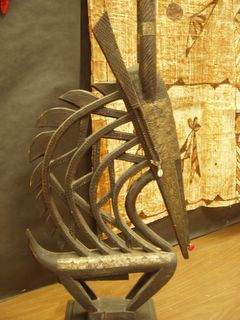
Detail of Chiwara Mask from Bambara of Mali, Africa. The first time I saw a chiwara mask was in the video, African Art, which had just a small clip of people in a small village talking about the importance of this ritual dance, done just before planting. The dance/ritual commemorated how the Bambara learned how to till the ground with a tool rather than by hand, probably adapted from the antelope's horns. The video vividly shows the mask in context, costume, drum, music, and that thin line between forest and field. But a photograph can never capture the artifact itself -- which Gary Westford has made more accessible to us by creating the library display at LBCC. Very few of us can ever hope to see the chiwara mask as it was meant to be experienced, at the center of ritual.
This impressive mask is about 3 feet tall, with intricate carvings. Some sources report that only men dance with the chiwara mask; however, the masks themselves answer this question as we can see two styles of chiwara -- male and female. Gary's mask (above) shows a male mask; the woman's mask inclues a baby antelope; she symbolizes the earth, the baby symbolizes humankind.
The costume in the African Art video is made of raffia (a kind of straw), and Parrinder (see below) shows a mask with black and white cloth decorated with symbols of the universe. The ritual itself is to ensure fertility -- of the crops and of the community, much like the underlying roots to our own Passover or Easter for spring planting, and then in the fall, somewhat like Succot or Thanksgiving for harvest.

1 comment:
Thanks for the photo and comments on the chiwara. The internet, as far as I can tell, does not capture the full range and style of the carvings. There are 4-5 different styles, and many variations within each. I've presented some variations in the vertical carvings (like yours) on Picasa Larry W Harms. The photos are about 30 years old, so I've presented them as black and white. These photos are simply a sample of the breadth what exits with the vertical style.
Long live elements of the proud traditonal Africa! Larry
Post a Comment